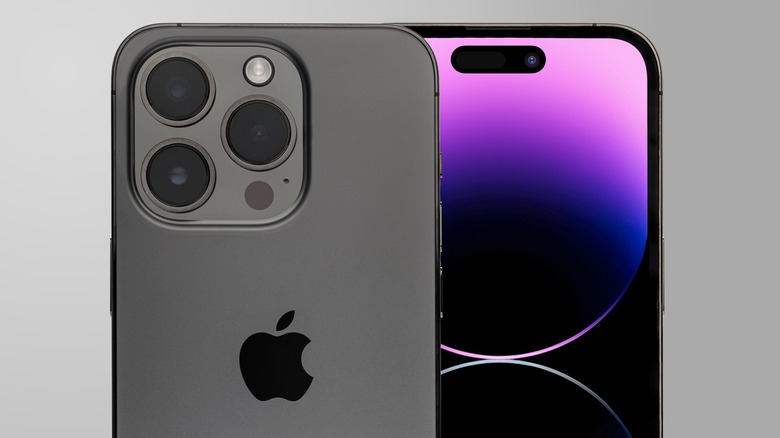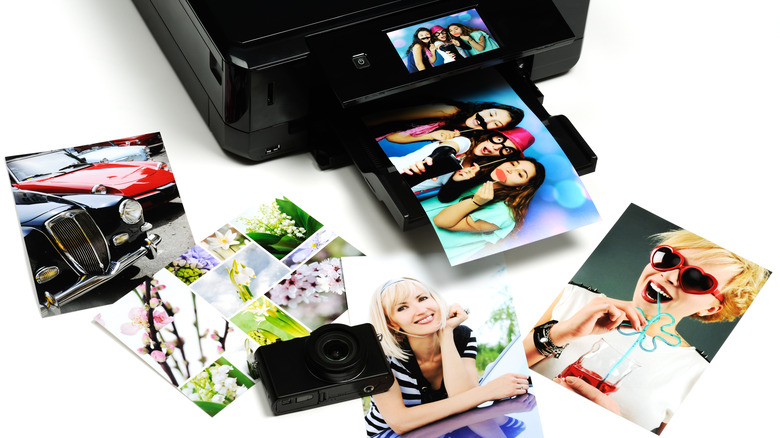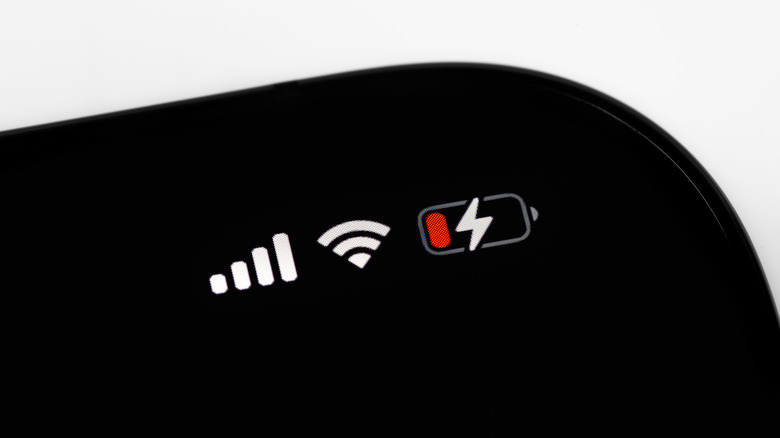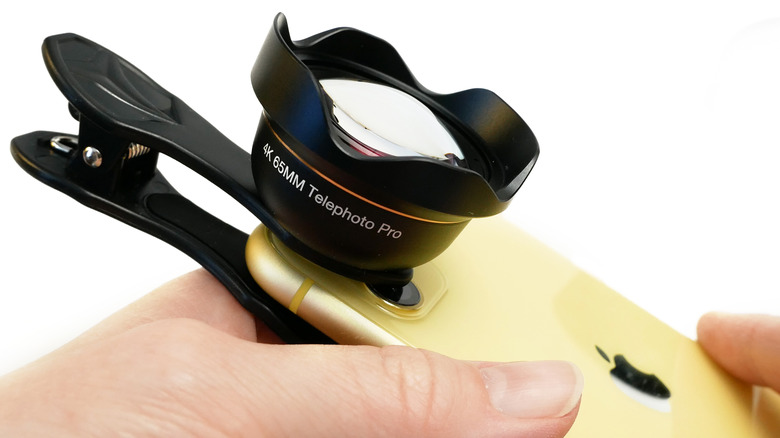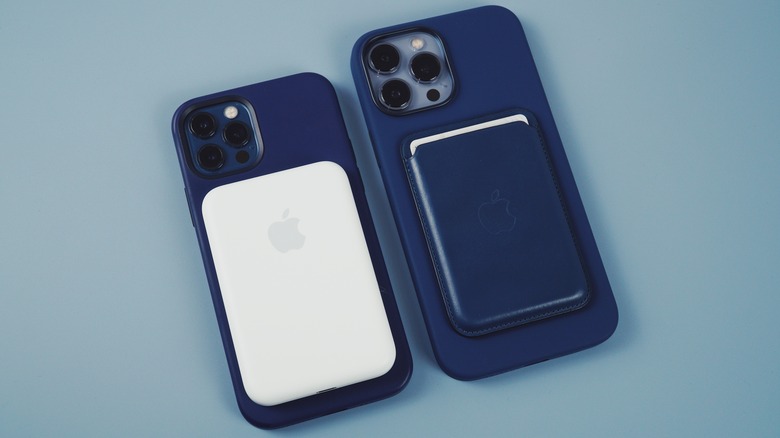iPhone Accessories That Are A Total Waste Of Money
Smartphones are effectively miniature computers that you can carry around in your pocket, and their ability to work with a huge range of accessories makes them even more useful. Some accessories are made by manufacturers, such as Samsung's S-Pen for its Galaxy devices, and others are certified as compatible, such as everything sold under Apple's MFi Program.
The iPhone is an excellent device regardless of whether you have one of the latest flagship models or an iPhone SE, and you can't go wrong with a certified "Made for iPhone" accessory. With that said, there's a vast catalog of unofficial and uncertified accessories on the market offered at prices for every budget, and not all of them are worth your dollars. In some cases, the accessories may sound great in theory but prove lackluster in practice; in other cases, they're nothing more than gimmicks that won't improve your experience and may even make it worse.
Miniature wireless photo printers
Mini photo printers that connect to a smartphone wirelessly seem like a good idea in theory — they're often described as the modern-day equivalent of old-school Polaroid instant cameras. Whether you get a name-brand version or one of the cheaper options from less-known brands, these printers generally work in the same way: you insert photo paper, connect the printer to your phone using Bluetooth, and then install the printer's companion mobile app. With that app, you can scroll through the images in your camera roll and wirelessly print any of them you'd like.
There are some very obvious limitations to these printers, not the least of which is their size: in most cases, the photos they print are 2x3s, which are effectively wallet-sized. Many of the photo paper products sold for these printers have adhesive on the back of each photo so that they can also be used as stickers. That makes the printers a great gift for a child or teenager who may want to plaster their locker or bedroom wall with fun memories, but beyond that, there's no good reason to spend $60+ on one of these devices when the resulting photos are fairly low quality and painfully small.
It's worth noting that most stores with photo-printing services now allow customers to directly upload images from an Android device, iPhone, or iPad, and they usually offer a wide selection of photo paper sizes and types, including matte and glossy. While waiting to pick up an order or receive it in the mail lacks the novelty of printing out a bunch of small instant photo stickers, the resulting product is likely something you'll appreciate more in the long run.
Battery cases
Years ago, phones took hours to charge and their runtimes were modest at best. This unfortunate combination gave rise to a market of third-party accessories that revolved around power management — specifically, about extending how long a phone would run before the user had to find an outlet. Battery cases are one such example, having served as a vital middleman between the smartphone and the user in hopes of keeping one alive long enough to get the other through the workday.
Battery cases were always a compromise between function and form: they're typically thick, heavy, and aesthetically clunky. That's no surprise, as they're literally just large battery packs swaddled in silicone and plastic that can be popped onto a smartphone in the same way as a protective case. The upside is that by packing the battery into the case, the user doesn't have to tote around a standalone power bank and a USB cable.
While battery cases remain a thing, their utility has decreased dramatically as battery technology and energy management methods have improved. Most new smartphones — even many mid-range ones, particularly from Chinese brands — support fast charging, which may recharge the battery to a substantial percentage in as few as 10 minutes. The iPhone is no exception, and iOS is notoriously excellent at managing battery consumption, resulting in, for example, the base-tier iPhone 14 with its ability to reach 50% battery in half an hour (via Apple). Unless you plan to take your phone with you on frequent trips away from modern society and anything resembling electrical infrastructure, it's a waste of money to buy a battery pack when less than an hour on the charger will give you enough battery to get through a full day.
Clip-on lenses
Cellphone cameras used to be less than stellar, and you'd typically see people toting around a dedicated point-and-shoot digital camera in addition to their handset. That slowly changed over time, and then seemingly at breakneck speeds; it wasn't long before the digital camera market was in shambles as most consumers used smartphones for all of their memory-capturing needs. Cameras remained a key selling point for smartphone manufacturers, leading to the rise of multi-sensor camera modules, telephoto and ultra-wide-angle lenses, and optical image stabilization built into ordinary phones. Artificial intelligence has joined the mix to take things even further via what is known as computational photography, making it possible to erase entire people from photos with a tap.
All of that is to say, modern smartphone cameras — especially the ones found on high-end models like the latest flagship iPhone generations — are very capable on their own and tossing accessories like clip-on lenses into the mix will likely degrade the resulting product rather than improve it. Even if you have an old or budget iPhone like one of the SE models, it's probably a good idea to avoid clip-on lenses; most of them are inexpensive and have poor construction as a result, including cheap optical glass and plastic clips that let small amounts of light leak into the lens barrel. This results in things like bright spots, glares, and streaks in videos and images, as well as general image distortion. It's also possible that repeatedly clipping a lens onto your phone could scratch it over time unless you buy ones that work with a specially designed case, driving up the cost for what is ultimately little value in the end.
Gimmicky MagSafe accessories
MagSafe is no longer a novelty on the iPhone, but some of the third-party accessories designed to utilize it are — and if you give in to temptation and buy one of them, you'll likely find that you wasted your money in the long run. For every useful iPhone MagSafe accessory on the market, you can find a seemingly endless number of cheap, gimmicky products ranging from decorations to seemingly useful offerings that aren't so useful in everyday life.
For example, some iPhone users report issues with MagSafe-based grips designed to make it easier to hold the handset. While great in theory, these devices are attached magnetically and may become dislodged at the worst possible time, resulting in a very expensive phone taking an equally expensive tumble. In other cases, some of these accessories may interfere with heat dissipation, leading to an overheated phone — that, in turn, will cause the battery to degrade faster, putting you on the fast track to poor battery health and the need for a replacement.
